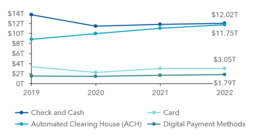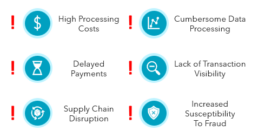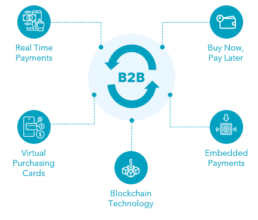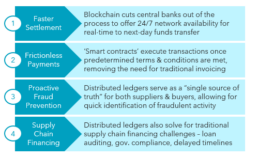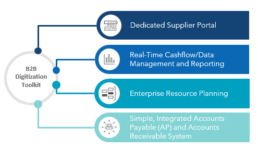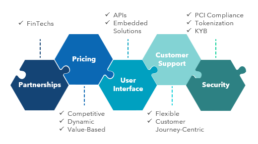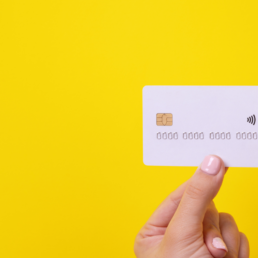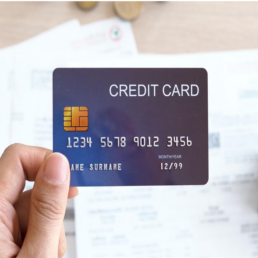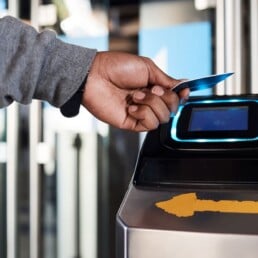Rethinking B2B Payments
The business-to-business (B2B) payments ecosystem, long characterized by complex, manual processes, has reached an inflection point. The proliferation of digital payment methods is fundamentally reshaping how businesses and consumers manage their finances.
As B2B payment innovation accelerates, financial institutions and banks failing to meet elevated expectations risk losing significant market share to FinTech disruptors. A recent study found that ¾ of corporate customers consider money management a challenge when executing B2B payments. And yet, while 66% of financial institutions consider digital payment offerings a key success factor, only 30% believe their current tools effectively reduce friction for their customers.1
The consumerization of B2B payments means successfully retaining market share will require banks and FIs to not only digitize payments themselves, but also provide efficient solutions to the entire payments workflow. From dedicated supplier portals to automated Accounts Payable (AP) and Accounts Receivable (AR) systems, the B2B customer experience will be defined by customized solutions, simple cash flow management, and a streamlined payment cycle.
Executing a future-proof digital innovation strategy is pivotal for any bank or financial institutions’ long-term success. While the B2B payments space represents a sea of opportunity, fierce competition has incited a digital arms race!
The global transaction value of business-to-business (B2B) payments reached just over $88 trillion in 2022 and is expected to exceed $111 trillion by 2027.2 However, while B2C Ecommerce solutions have expanded globally, revolutionizing how consumers spend and send money in real-time, B2B buyers still overwhelmingly default to old school payment methods. Roughly 40% of all B2B payments in the United States are still executed via paper check or cash:
Exhibit 1. US B2B Payment Transaction Value, by Transaction Method, 2019-2022 (in Trillions)
Buyers and suppliers relying on antiquated payment processes experience pain points that negatively impact their bottom line:
1.High Processing Costs:
Manual payment operations, on average, cost businesses 2% of their annual sales, while payment processing costs another 0.8%.4
2. Delayed Payments:
~47% of suppliers are paid late for their products or services.5 Payment delays are largely due to the extensive B2B payments process – a B2B transaction involves (1) the creation of a purchase order by the buyer, (2) the fulfillment of the order by the supplier, (3) the creation of an invoice from the supplier’s Accounts Receivable (AR) department, and (4) the processing and payment of the order by the buyer’s Accounts Payable (AP) department.
Exhibit 2. Manual B2B Payment Pain Points
3.Supply Chain Disruption:
B2B movements in supply chains typically outpace their underlying cross-border payments, which results in bottlenecks and loss of value.
4.Cumbersome Data Processing:
Manual payment processes often pose a challenge for businesses reconciling multiple invoices and receiving and processing remittance data. Missing data elements in the files, the use of inconsistent file formats, and the lack of back-office support for automated remittances pose significant challenges for data processing.
5.Lack of Transaction Visibility:
Manual payments provide for limited end-to-end transaction tracking, which may result in delays, additional costs, chargebacks, and payment cycle disruption.
6.Increased Susceptibility to Fraud:
Paper checks are more susceptible to commercial fraud than any other payment method, with 2/3 of organizations experiencing check fraud (2022).
Covid-19 exacerbated pain points around managing invoicing and payments in the B2B value chain and helped catalyze digital adoption. As the pandemic wreaked havoc on supply chains across the globe, suppliers realized the need for transparent, end-to-end tracking of goods.
Inefficient processes, coupled with elevated customer expectations, are driving a new wave of payment digitization. One study forecasts that 80% of all B2B payments will be digital by 2025.
...But a complicated problem
While payment digitization has reshaped the B2C space – with over 70% of B2C payments made electronically – electronic B2B payments has significantly lagged in adoption across industries and remains an underpenetrated market. Two major contributing factors to this slowed adoption are (1) the nuanced nature of cross-border payments and (2) the inherent complexity of B2B vs. B2C payment transactions.
CROSS-BORDER PAYMENTS
Cross-border B2B payments, where the payee and transaction recipient are based in different countries, are notoriously complex and difficult. In fact, over a quarter of small-to-medium-sized businesses rank the complexity of executing cross-border payments as one of their top obstacles. Often touching many intermediaries, cross-border payments frequently lead to unpredictable delays. Business seeking to execute cross-border payments face several challenges:
Inconsistent Regulation:
Regulatory adherence and the tightness of controls around Your Customer (KYC) and Anti-Money Laundering (AML) vary per country. For instance, while AML controls are more established in Europe, the controls in Africa, and particularly North Africa, may be less defined or rigorous. This means an increased likelihood of payment delays due to AML problems.
Lack of API Interoperability:
While Application Programming Interfaces (APIs) facilitate information sharing across different payment networks and systems, they can only communicate with each other if they are interoperable. Currently, there is a distinct lack of global interoperability and standardization, with only 38% of payment system operators reporting the existence of domestic standards for APIs.8 Lack of API standardization means that cross-border payments will remain a challenge for B2B payments.
Corridor + Currency Complications:
The setup required to support a B2B client’s business in a new corridor or currency is often cumbersome. Receiving banks lack visibility into when payments will arrive and are therefore unable to provide status updates to their customers/suppliers. Moreover, the amount of money involved in a transaction may change as a result of exchange calculations and various fees.
COMPLEXITY OF B2B VS. B2C
While B2C payment transactions typically compromise of small, one-off purchases executed via synchronous, real-time payment methods (e.g., debit/credit cards, PayPal, Venmo, etc.), B2B payments are considerably more complex.
B2B transactions typically require an extensive decision-making process with inputs and approvals from multiple stakeholders across different departments of an organization. Asynchronous payment methods, coupled with large order quantities that may contain thousands of individual line items, lead to 30–90-day payment terms.
As technology makes global ventures easier to launch and manage, the proliferation of new cross-border B2B businesses has made it more important than ever for financial institutions and corporations to streamline B2B payments.
Exhibit 3. B2B vs. B2C Payment Transactions
The new wave of digital payments
Digital payment methods are addressing B2B customers’ pain points and modernizing the B2B payments ecosystem by offering real-time or same-day payments, elevated security, and transparent bi-lateral communication between buyers and suppliers. The digital payments revolution is being driven by several electronic payment solutions:
Exhibit 4. Digital B2B Payment Solutions
REAL TIME PAYMENTS
A real-time payments (RTP) rail is the digital infrastructure that facilitates payments that are initiated and settled almost instantaneously. RTP are streamlining the payment delivery process for B2B customers by providing benefits that directly impact their bottom line:
1.Increased Savings: Manual payment processes cost B2B customers $25+ per transaction, whereas RTP often cost less than $1 per transaction.10
2. Boosted Efficiency: Near-instantaneous settlement prevents bottlenecks in supply chain execution.
3. Elevated Transparency: RTP provide both parties, payer and payee, notifications of confirmations and settlements. Establishing bilateral communication facilitates trustworthy payments between businesses.
RTP have proven particularly disruptive in the cross-border payments space. Leading financial services firms have designed networks to enable participating financial institutions to execute secure, efficient global business payments. For instance, Visa’s B2B cross-border payments solution, Visa B2B Connect, provides its customers with seamless bank-to-bank cross-border transactions via a non-card-based payment network. Businesses use Visa’s multilateral network to send irrevocable payments in full to the beneficiary’s bank with exact confirmation of funds delivery.
Exhibit 5. Visa B2B Connect Functionality
By offering a global network, Visa B2B Connect’s customers avoid intermediary fees and are ensured clarity on financial exchange rates. Visa is also able to ensure data privacy via a digital identity feature that tokenizes an organization’s sensitive business information, providing them with a unique identifier.
VIRTUAL PURCHASING CARDS
While purchasing cards have revolutionized the B2B payments sector since their mainstream market acceptance in the mid-90’s, 2021 saw the inception of a more secure, digitally-enabled p-card – the Virtual Card. Virtual Cards are essentially “card-less” credit cards that generate a unique 16-digit card number issued for a specific supplier/organization with a pre-set, one-time payment amount. The cards are processed by vendors similarly to traditional credit or pay cards, yet do not require a physical card or open line of credit. Payments via Virtual Card are sent directly to a supplier’s account without any action needed on behalf of the supplier.
Virtual Cards promise elevated security for corporate expenditure from travel to procurement. The unique card number feature ensures that even if the card is compromised, its pre-set pay limit, expiration date, and organization designation prohibit unanticipated spending. Virtual Card payments are anticipated to grow to over $65 billion by 2030.11
Virtual cards have seen increased adoption within the hospitality industry. Online Travel Agencies (OTAs), which operate with relatively thin margins, leverage virtual cards to reduce inefficiencies when purchasing from tourism suppliers. Customers booking their vacations might chose to bundle lodging and car rental booking through an OTA like Expedia or Kayak. As they proceed through the checkout flow, they may choose to upgrade their booking through a loyalty program or add an insurance program from yet another vendor. Virtual card solutions allow for logic to programmatically create a card for each order and automate otherwise entirely manual processes.
BLOCKCHAIN TECHNOLOGY
While it is a popular subject of controversial press, Blockchain technology’s potential to fundamentally change the payments landscape is undeniable. At its core, blockchain is an advanced database mechanism that allows for transparent information sharing within a business network. It creates a decentralized, immutable ledger of chronologically consistent data that cannot be altered or deleted without consensus from the network.
Exhibit 6. Benefits of Blockchain for Businesses
Whereas public blockchain networks are permissionless and allow all users to read, edit, and validate the blockchain, businesses seeking to securely execute B2B payments require access to private, hybrid, or consortium blockchain networks. These networks feature access restrictions that ensure secure data flow. However, implementing a new blockchain network is costly and resource-intensive.
Blockchain-as-a-Service (BaaS) provides businesses a shortcut by packaging the smart contract technology, blockchains, and network infrastructure they run on. Emerging FinTechs, like PayStand, Bloq and Dragonchain, as well as established tech giants, like Amazon, offer B2B clients blockchain solutions at a fraction of the cost.
EMBEDDED PAYMENTS
Embedded payments promise stickier customer relationships, increased buying ease and convenience, and fewer days sales outstanding (DSO). While online shopping historically required payment processing to be executed via a third-party provider or banking service, embedded payments seamlessly integrate financing and digital payment processing into the ecommerce journey. Payments, therefore, feel more like a natural extension of customer engagement as opposed to a separate, cumbersome activity.
In the B2C arena, embedded payments have become the status quo –Amazon shoppers and Uber riders have grown accustomed to executing payments in-app at the click of a button. To provide a similarly convenient payment experience, B2B embedded payments must provide connective tissue between all aspects of the payment’s workflow – from invoicing to funds disbursement.
While embedded payments are still in early adoption in the B2B space, emerging FinTechs are embracing the long-term value that embedded capabilities deliver. In one example, via a partnership with OpenText, BigCart’s payment solutions are now offered to businesses running OpenText’s cloud-based supply chain management software, providing upwards of 1.1 million trading partners access to embedded offerings.
BUY NOW, PAY LATER
US firms alone account for upwards of $3 trillion accounts receivables on any given day. The BNPL value proposition promises better cash flow management through on-demand settlement of invoices. Providers typically take on the risk of late or unpaid invoices to help better match buyer and supplier cash flows. The matching of cash dynamics allows suppliers to settle transactions faster while providing buyers the ability to increase predictability of cash outflows. B2B BNPL directly improves supply chain throughput and allows businesses to grow without the need for traditional financing. For in-depth Kepler Cannon insights on BNPL, see Navigating the Buy Now Pay Later Era.12
New age BNPL offerings will need to leverage outsourced or automated underwriting to provide significant advantage over conventional credit checks. By accelerating cash flow and potentially reducing the cost of borrowing, providers will be able to effectively showcase value and acquire customers at scale.
The unprecedented size of the market coupled with better risk visibility has led to the emergence of several innovators in the space. New age BNPL players such as Billie, Tillit & Tranch are building highly customized, industry focused solutions using latest technology which allows them to rapidly acquire share from slow moving financial institutions.
The consumerization imperative
Like consumers, businesses require efficient, secure payment methods tailored to their needs. However, B2B payments cannot be viewed in isolation, but rather as part of a broader set of processes involving purchase orders, invoices, payment terms, cashflow management, and accounts payable (AP) and accounts receivable (AR) departments. In order to thrive amidst growing FinTech disruption, banks and financial institutions must streamline the entire payments workflow by expanding their digital toolkit.
Exhibit 7. Bank/FI Digitization Toolkit
Dedicated Supplier Portal. Dedicated supplier portals are the foundation of a simplified B2B procurement process. By automating many of the traditionally manual steps in a B2B transaction – from issuing purchase orders to providing access to related invoices – supplier portals expedite the entire payment cycle. Portals also maintain a central log of all updates regarding a purchase order, serving as a transparent, single source of truth for both the vendor and the buyer.
Real-Time Cashflow/Data Management and Reporting. Cash flow challenges, intensified by late payments and rising inflation, pose an immediate threat to all businesses, but especially small and medium-sized businesses (SMBs). All-in-one payments platforms provide a comprehensive solution for automated reporting and working capital management. By identifying constraints in the invoicing process, businesses can realize revenue more quickly.
Enterprise Resource Planning. Enterprise Resource Planning (ERP) platforms integrate all essential functions of a business and enable data flow between them. Integrating payments via an ERP reduces IT costs, inventory levels, and payment cycle time. By reducing AP volume, 95% of businesses leveraging ERPs improved their businesses processes and 82% improved met projected timelines for the systems’ ROI.13
Simple Integrated Accounts Payable and Accounts Receivable System. Automating AP and AR functions expedites two of the most repetitive, manual processes in the payments workflow and allows for faster payment reconciliation.
Automating AP removes the need for finance teams to collect, sort, and verify transaction receipts. Similarly, Automating AR allows businesses to set certain invoices as recurring and send them automatically at particular dates, rather than having to create a new invoice each month.
Building a future-proof digital strategy
In order to successfully execute a future-proof digital innovation strategy, banks and financial institutions must consider several elements to streamline the entire payments workflow.
Exhibit 8. Digital Strategy Considerations
PARTNERSHIPS
While implementing an entirely new digital payment rail is resource and time-intensive, banks and FIs can leverage FinTech partnerships to upgrade their legacy technology. Banks and FIs should maintain a customer-centric focus when identifying what needs a potential partnership might solve. Some considerations include:
1.Which FinTechs will facilitate a streamlined payment experience or increase speed-to-market for your largest accounts? (I.e., global players seeking to execute transactions in new corridors or complex use cases)
2. What IT gaps would the partnership solve? Will the FinTech facilitate seamless data flow to your ERP?
3. Would the partnership help automate part or all of the payments workflow? (purchase orders, invoicing, AP and AR functions, etc.)
PRICING
A fundamental element to a best-in-class digital B2B payment solution is competitive pricing for buyers and suppliers. Banks and FIs should have a thorough understanding of how their value proposition holds up against disruptive market entrants seeking to capture price-sensitive customers. Some considerations include:
1.How will pricing vary by customer segment or offering? (e.g., self-service for standard clients and on-demand white glove support for strategic accounts)
2. What data/benchmarks can be leveraged to reduce leakage and improve overall pricing performance?
3. Is your commercial team upskilled enough to communicate strong value messaging and pricing considerations to customers?
USER INTERFACE
Improving the point of contact for B2B customers is a key concern for any bank or FI’s success in the age of consumerized payments. APIs and embedded solutions are essential assets to improve the customer experience, fuel innovation, and generate growth from corporate customer segments. Some considerations include:
1.What constitutes a comprehensive API strategy and road map for your customer base? (e.g., geographic and segment considerations, onboarding complexities, shifting regulation and standardization)
2. How will you align KPIs and incentives across internal functions to ensure a product-centric roll out of new API-enabled products and services?
3. How will you align front and back-office departments to provide a wholistic embedded solution? (e.g., PO numbers, AP/AR systems, ERP integration)
CUSTOMER SUPPORT
Offering elevated, proactive customer support can be a key differentiator in an ever-changing digital environment. Banks and FIs should consider optimal support a strategic advantage. Some considerations include:
1.Are the educational materials you provide customers pointed and use case-specific? (e.g., detailed onboarding guides, multi-lingual FAQs, anticipated payment timeline overviews)
2. Do you couple an easily-accessible website support portal with efficient query escalation protocols? (e.g., direct contact support line, community forums, conflict resolution KPIs)
SECURITY
Ensuring a safe, secure B2B payments process is paramount for banks and FIs. Some considerations include:
1. Have you implemented PCI-compliance checklists for employees and customers? (e.g., strong access control measures, periodic network tests, malware and antivirus protection)
2. How are you addressing regulatory standards for Know Your Business (KYB) ?
Are you offering diverse, unique tokenization technologies to protect customer data throughout the payments process?
In closing...
Accelerated digital payments adoption represents the end of cumbersome, manual B2B payment methods. Digitally-enabled disruptors that are better equipped to meet customers’ elevated expectations threaten to steal significant market share from legacy banks and financial institutions over the long term.
One dimensional digital solutions will fall short of accommodating the inherent complexity of B2B payments. Succeeding in the B2B space will require a customizable offering that streamlines the entire payments workflow.
In order to thrive in the new age of digital payments, Banks/FIs need to hit the bull’s eye in expanding their digital toolkits and executing a future-proof digital innovation strategy. Dedicated supplier portals, cashflow management solutions, Enterprise Resource Planning, and integrated Accounts Payable and Accounts Receivable systems are the digital backbone behind consumerized B2B payments. Adequately assessing the gaps in its current value proposition will prove to be a make-or-break strategic imperative for any bank or FI.
__________________________________________________________________________________________________________
- PAYMENTS
- Juniper Research
- Insider Intelligence
- PAYMENTS
- Digital Commerce 360
- J.P.Morgan
- PAYMENTS
- PAYMENTS
- FT Partners
- FIS
- Global News Wire
- Navigating the Buy Now Pay Later Era, Kepler Cannon
- PAYMENTS
